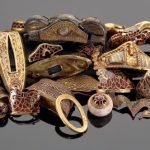 Music
Music  Music
Music  History
History 10 Less Than Jolly Events That Occurred on December 25
 Weird Stuff
Weird Stuff 10 Funny Ways That Researchers Overthink Christmas
 Politics
Politics 10 Political Scandals That Sent Crowds Into the Streets
 Weird Stuff
Weird Stuff Ten Bizarre Facts About The Doge Meme
 Our World
Our World 10 Ways Your Christmas Tree Is More Lit Than You Think
 Movies and TV
Movies and TV The 10 Coolest Stars to Set Sail on The Love Boat
 History
History 10 Things You Didn’t Know About the American National Anthem
 Technology
Technology Top 10 Everyday Tech Buzzwords That Hide a Darker Past
 Humans
Humans 10 Everyday Human Behaviors That Are Actually Survival Instincts
 Music
Music 10 Surprising Origin Stories of Your Favorite Holiday Songs
 History
History 10 Less Than Jolly Events That Occurred on December 25
 Weird Stuff
Weird Stuff 10 Funny Ways That Researchers Overthink Christmas
Who's Behind Listverse?

Jamie Frater
Head Editor
Jamie founded Listverse due to an insatiable desire to share fascinating, obscure, and bizarre facts. He has been a guest speaker on numerous national radio and television stations and is a five time published author.
More About Us Politics
Politics 10 Political Scandals That Sent Crowds Into the Streets
 Weird Stuff
Weird Stuff Ten Bizarre Facts About The Doge Meme
 Our World
Our World 10 Ways Your Christmas Tree Is More Lit Than You Think
 Movies and TV
Movies and TV The 10 Coolest Stars to Set Sail on The Love Boat
 History
History 10 Things You Didn’t Know About the American National Anthem
 Technology
Technology Top 10 Everyday Tech Buzzwords That Hide a Darker Past
 Humans
Humans 10 Everyday Human Behaviors That Are Actually Survival Instincts
10 Ordinary Things That Debuted at World’s Fairs
In London in 1851, the Exhibition of the Works of Industry of All Nations was held. The luxurious pavilions and grand attractions drew crowds from across the globe and began an impressive tradition of World’s Fairs.
These universal exhibitions were held frequently throughout the Victorian Era (and less frequently throughout the 20th and 21st centuries). We have these worldwide events to thank for iconic structures like the Eiffel Tower and the Space Needle in Seattle, Washington. T the fairs were also an opportunity for inventors and artists to show off what they’d been working on. Sometimes, these immediately took the world by storm, but sometimes, they slowly crept into the public consciousness.
Here are ten ordinary things you might not know debuted at World’s Fairs.
Related: Top 10 Game-Changing Recent Inventions and Innovations
10 Ketchup
It seems impossible to imagine eating a hot dog or french fries without the option of adding some ketchup. But before the 1876 Centennial International Exposition in Philadelphia, you would have been hard-pressed to find any that was being distributed on a commercial level.
It was here that the Heinz company, which at this point was mostly known for manufacturing horseradish, created a new tomato “catsup.” While tomato sauces had been popular since the 1700s, Heinz advertised its sauce as “Blessed relief for Mother and the other women in the household!” because it was much easier to buy it pre-bottled than make it at home. The Centennial Exposition allowed Heinz to distribute free samples and merchandise (including the iconic pickle pin,) skyrocketing the popularity of a classic American condiment.
The telephone also debuted at this fair, but I think we all know which is more important.[1]
9 Cherry Coke
While Coca-Cola has been around since 1886, it wasn’t until the 1982 World’s Fair in Knoxville, Tennessee, that the company capitalized on more flavors.
It was here, almost 100 years after the soda’s invention, that Cherry Coke debuted. It was intended to imitate the taste of cherry sodas made at soda fountains in local drugstores before canned or bottled soda was popular. Thus, while cherry cola had been around for a long time, this was the first time Coca-Cola was actually creating it themselves. The cherry variation of Coke was immediately a hit, and three years later, it was released to the public.
Today, you can buy not just cherry-flavored Coke but also vanilla, lime, orange, and many other limited-edition flavors.[2]
8 Color Television
The 1964 World’s Fair in New York City’s belle of the ball was Radio Corporation America. In a time when television was taking over the country, RCA installed over 250 televisions across the fairgrounds. But not just any televisions—color ones.
Though TVs weren’t exactly rare in the 1960’s, regular civilians had never seen screens with color before. As if this wasn’t enough, RCA had a special treat for fairgoers. They could see themselves on screen in the RCA pavilion! A color TV studio was also featured, where visitors would watch announcements and reports take place live.
Oddly enough, lost children got a special treat. They were televised across the fair in order to help parents find them from wherever they were within the pavilion.[3]
7 Cellophane
No trip to Grandma’s would be complete without a little piece of candy, usually wrapped in clear plastic called cellophane. At the 1939 World’s Fair in New York City, you could watch this tradition be created in real time at the “Wonderful World of Chemistry” exhibit. This area of the fair featured a candy wrapping machine, which wrapped up to 400 pounds of hard candy with cellophane every day.
Cellophane is still used on a daily basis by florists, gift wrappers, and food product companies, but it’s not quite the attraction it was in the early 1900s.[4]
6 Zipper
Though it was invented and patented back in 1851, the “automatic continuous clothing closure” did not rise in popularity until 1893, when inventor Whitcomb Judson presented his “clasp locker” at the Chicago World’s Fair.
Judson’s version of the clasp was originally intended just for shoes, but as the patent notes, it could be useful for many kinds of clothing. While the clasp was not an instant hit at the fair, having to compete with Buffalo Bill shows and the Ferris wheel, Judson was inspired by interest from corporations. By 1920, “zippers,” so-called for the sound they made, were commonplace on boots. From there, they became popular on children’s clothing and grew into the staple we know them as today.[5]
5 Pay Toilets
In most European countries, you’ll find no shortage of toilets to relieve yourself—as long as you have a few Euros.
Though they aren’t widely used in America, pay-per-use toilets can be found all across the world, from Mexico to Singapore. However, the first one premiered at the Great Exhibition World’s Fair in 1851. Almost a million visitors paid a penny to pee in the “monkey closets,” and the toilets were such a success they stayed up long after the rest of the fair was taken down.
“Spending a penny” became a Victorian-Era euphemism for using the bathroom. However, for a penny, they got quite a bit more. Each penny at the fair got you a comb and shoe shine included in the visit to the water closet.[6]
4 Dishwasher
Spite is a great motivator.
In 1883, Ohio housewife Josephine Cochrane was done wasting time cleaning up after dinner parties, allegedly saying, “If no one else is going to invent a dishwashing machine, I’ll do it myself.” And that’s what she did.
Just three years later, Cochran patented her hand-powered dishwashing machine. Unfortunately, investors refused to collaborate with Cochran unless she handed over control to a man, which she wouldn’t do. In 1893, Cochran got the opportunity to show off her machine at the Chicago World’s Fair. She won the prize for “best mechanical construction, durability and adaptation to its line of work,” and restaurants and stores from around the world clambered to learn how it worked.
For the first few years, dishwashers were only used in large batches, such as for hotels and stores. It wouldn’t be until the 1950s, after Cochran had died, that they became a luxury for personal homes.[7]
3 Moving Walkway
Take a stroll through almost any airport in the world, and you’ll find adults and children alike marveling at the wonder of the moving walkway. Even in 2024, these futuristic mechanical sidewalks are fascinating to use (and great for tiring kids out during long layovers).
The idea for a moving sidewalk came about from French engineer Eugene Henard, who planned to debut it at the 1889 World’s Fair in Paris. Unfortunately, he was unable to complete the invention before then, and it wasn’t until 1893 that it would come to fruition. At the Chicago World’s Fair, inventor Joseph Lyman Silsbee created the first version of the moving walkway, which featured a section for riders to sit and another to stand or walk.
The walkway frequently broke down and thus did not make a huge impact on guests at the fair. Luckily, Silsbee had another opportunity to show off the contraption at the 1900 World’s Fair, also in Paris. This one was much more successful and was even featured in a few of Thomas Edison’s early short films.
As people began to imagine what the future might look like, automated walkways crept into the public’s eye. In 1962, the titular family in The Jetsons introduced their own personal moving walkways, called “slidewalks.” Today, we’re practically living in 2062 with George and Jane, as we can walk on moving walkways at amusement parks, zoos, museums, and airports around the globe.[8]
2 Ice Cream Cone
Much like the popsicle, the invention of this summer staple came out of pure luck.
In 1904, St. Louis had the honor of hosting the World’s Fair. The summer’s heat meant ice cream was selling out fast. So fast that the “penny licks,” small serving glasses that were returned and reused by the vendors, had run out.
A Syrian concessionaire named Ernest Hamwi quickly curled one of his zalabias (a waffle-like pastry) into a conical shape and scooped the ice cream right into it, thereby creating the ice cream cone. In an interview years later, Hamwi said that as soon as they saw the cones, other ice cream vendors came up to him and bought the waffles to create their own cones, calling them “cornucopias.”
While it’s not certain that this was the first version of the ice cream cone, historians are certain this is what popularized it, as the St. Louis Globe-Democrat wrote in amazement about fairgoers eating ice cream out of “an inverted cone of hard cake, resembling a coiled-up waffle.”
1 Ferris Wheel
Now an iconic sign of summer carnivals and big cities all over the world, the Ferris wheel started as a rival to the Eiffel Tower.
Gustave Eiffel’s wrought-iron lattice tower debuted in 1889 at the Paris Exposition—also known as the Paris World’s Fair. It instantly became a symbol of the City of Love and hosted over two million visitors during the fair. So when Chicago was selected as the host of the 1893 World’s Fair, the Second City knew they’d have to create something big to rival Gustave Eiffel’s building.
What they came up with was a 231-foot (70.4 meter) tall wheel that was able to carry up to 2,160 people throughout its 36 cars. Designed by George Ferris, the wheel was intended to be a temporary creation. It was dismantled at the end of the fair in 1894. But that was far from the end of this amusement ride. Its thrilling (at the time) nature and ability to show off city skylines made it a staple in public celebrations.
Though it’s world famous, the Ferris wheel probably isn’t Chicago’s most famous Ferris. That goes to Mr. Bueller, of course.[10]








